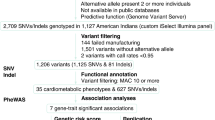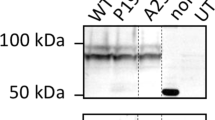Abstract
Objective:
To test if sequence variations of the SYNTAXIN 1A (STX1A) gene contribute to the susceptibility to type 2 diabetes in a cohort of overweight/obese subjects.
Methods:
A total of 717 overweight/obese individuals underwent oral glucose tolerance test and were stratified in four groups according to fasting and 2 h glucose levels (NGT, IGT, CGI, T2DM), representing the natural history of diabetes from normal glucose tolerance to overt disease. These subjects were analysed by a two-step genetic study. Functional analysis was performed by electrophoretic mobility shift assay (EMSA) and by supershift with CCAAT/enhancer-binding protein (C/EBP)β antibody.
Results:
Among the several sequence variations detected in the STX1A gene, the T allele of the −352 A>T single nucleotide polymorphism in the promoter was found in a lower frequency in the subset of individuals with greater impairment of insulin secretion (CGI). To confirm that a lower frequency of the T allele was associated with this condition, we genotyped a second group of 202 overweight/obese individuals with type 2 diabetes, and the frequency of the T allele was reduced in this group also (P<0.01). Logistic regression confirmed a protective odds ratio (0.49, P<0.01) for the T allele. The EMSA showed that the PRM −352 A allele binds transcription factors with lower affinity compared to the T allele, and incubation with C/EBPβ antibody ‘supershifted’ the complex, indicating that C/EBPβ had a different binding with the PRM −352T allele.
Conclusion:
A lower frequency of the PRM −352T allele of the STX1A gene was observed in overweight/obese subjects with impaired glucose regulation, particularly among individuals with combined glucose intolerance and overt diabetes. Both these groups have a greater defect in β-cell function compared to normal and glucose intolerant subjects, and this association together with the functional study suggests a possible role of the PRM −352 A>T variant in insulin secretion.
This is a preview of subscription content, access via your institution
Access options
Subscribe to this journal
Receive 12 print issues and online access
$259.00 per year
only $21.58 per issue
Buy this article
- Purchase on Springer Link
- Instant access to full article PDF
Prices may be subject to local taxes which are calculated during checkout


Similar content being viewed by others
References
UK prospective diabetes study 16. Overview of 6 years’ therapy of type II diabetes: a progressive disease. UK Prospective Diabetes Study Group. Diabetes 1995; 44: 1249–1258.
McCarthy MI . Progress in defining the molecular basis of type 2 diabetes mellitus through susceptibility-gene identification. Hum Mol Genet 2004; 1: 33–41.
Rorsman P, Renstrom E . Insulin granule dynamics in pancreatic beta cells. Diabetologia 2003; 46: 1029–1045.
Jacobsson G, Bean AJ, Scheller RH, Juntti-Berggren L, Deeney JT, Berggren PO et al. Identification of synaptic proteins and their isoform mRNAs in compartments of pancreatic endocrine cells. Proc Natl Acad Sci USA 1994; 91: 12487–12491.
Gerst JE . SNAREs and SNARE regulators in membrane fusion and exocytosis. Cell Mol Life Sci 1999; 55: 707–734.
Yang SN, Larsson O, Branstrom R, Bertorello AM, Leibiger B, Leibiger IB et al. Syntaxin 1 interacts with the L(D) subtype of voltage-gated Ca(2+) channels in pancreatic beta cells. Proc Natl Acad Sci USA 1999; 96: 10164–10169.
Pasyk EA, Kang Y, Huang X, Cui N, Sheu L, Gaisano HY . Syntaxin-1A binds the nucleotide-binding folds of sulphonylurea receptor 1 to regulate the KATP channel. J Biol Chem 2004; 279: 4234–4240.
Nagamatsu S, Nakamichi Y, Yamamura C, Matsushima S, Watanabe T, Ozawa S et al. Decreased expression of t-SNARE, Syntaxin 1, and SNAP-25 in pancreatic beta-cells is involved in impaired insulin secretion from diabetic GK rat islets: restoration of decreased t-SNARE proteins improves impaired insulin secretion. Diabetes 1999; 48: 2367–2373.
Lam PP, Leung YM, Sheu L, Ellis J, Tsushima RG, Osborne LR et al. Transgenic mouse overexpressing syntaxin-1A as a diabetes model. Diabetes 2005; 54: 2744–2754.
Hanson RL, Ehm MG, Pettitt DJ, Prochazka M, Thompson DB, Timberlake D et al. An autosomal genomic scan for loci linked to type II diabetes mellitus and body-mass index in Pima Indians. Am J Hum Genet 1998; 63: 1130–1138.
Duggirala R, Stern MP, Mitchell BD, Reinhart LJ, Shipman PA, Uresandi OC et al. Quantitative variation in obesity-related traits and insulin precursors linked to the OB gene region on human chromosome 7. Am J Hum Genet 1996; 59: 694–703.
Fradin D, Heath S, Lathrop M, Bougneres P . QTLs for fasting glucose in young Europeans replicate previous findings for type 2 diabetes in 2q23–24 and other locations. Diabetes 2007; 56: 1742–1745.
Volchuk A, Wang Q, Ewart HS, Liu Z, He L, Bennett MK et al. Syntaxin 4 in 3T3-L1 adipocytes: regulation by insulin and participation in insulin-dependent glucose transport. Mol Biol Cell 1996; 7: 1075–1082.
Tsunoda K, Sanke T, Nakagawa T, Furuta H, Nanjo K . Single nucleotide polymorphism (D68D, T to C) in the syntaxin 1A gene correlates to age at onset and insulin requirement in Type II diabetic patients. Diabetologia 2001; 44: 2092–2097.
Levy JC, Matthews DR, Hermans MP . Correct homeostasis model assessment (HOMA) evaluation uses the computer program. Diabetes Care 1998; 21: 2191–2192.
Nakayama T, Fujiwara T, Miyazawa A, Asakawa S, Shimizu N, Shimizu Y et al. Mapping of the human HPC-1/syntaxin 1A gene (STX1A) to chromosome 7 band q11.2. Genomics 1997; 42: 173–176.
Sentinelli F, Lovari S, Vitale M, Giorgi G, Di Mario U, Baroni MG . A simple method for non-radioactive PCR-SSCP using MDE gel solution and a midi gel format: application for the detection of variants in the GLUT1 and CTLA-4 genes. J Biotechnol 2000; 78: 201–204.
Wong AH, Trakalo J, Likhodi O, Yusuf M, Macedo A, Azevedo MH et al. Association between schizophrenia and the syntaxin 1A gene. Biol Psychiatry 2004; 56: 24–29.
Cavallo MG, Dotta F, Monetini L, Dionisi S, Previti M, Valente L et al. Beta-cell markers and autoantigen expression by a human insulinoma cell line: similarities to native beta cells. J Endocrinol 1996; 150: 113–120.
Baroni MG, Cavallo MG, Mark M, Monetini L, Stoeher B, Pozzilli P . cell gene expression and functional characterization of the human insulinoma cell line CM. J Endocrinol 1999; 161: 59–68.
Dignam JD, Lebovitz RM, Roeder RG . Accurate transcription initiation by RNA polymerase II in a soluble extract from isolated mammalian nuclei. Nucleic Acids Res 1983; 11: 1475–1489.
Abdul-Ghani MA, Jenkinson CP, Richardson DK, Tripathy D, DeFronzo RA . Insulin secretion and action in subjects with impaired fasting glucose and impaired glucose tolerance: results from the Veterans Administration Genetic Epidemiology Study. Diabetes 2006; 55: 1430–1435.
Ramji DP, Foka P . CCAAT/enhancer-binding proteins: structure, function and regulation. Biochem J 2002; 365 (Part 3): R561–R575.
Lu M, Seufert J, Habener JF . Pancreatic -cell specific repression of insulin gene transcription by CCAAT/enhancer-binding protein (C/EBP): inhibitory interactions with basic helix-loop-helix factor E47. J Biol Chem 1997; 272: 28349–28359.
Acknowledgements
This work was supported by research grants from the University of Cagliari (ex-60% 2005) and from the Ministry of the University and Scientific Research (all to Marco Giorgio Baroni). We thank S Rossano, M Fanelli and F Maiani for technical support, and our Mentor Professor Umberto Di Mario for constant inspiration and for being as an example.
Author information
Authors and Affiliations
Corresponding author
Rights and permissions
About this article
Cite this article
Romeo, S., Sentinelli, F., Cavallo, M. et al. Search for genetic variants of the SYNTAXIN 1A (STX1A) gene: the −352 A>T variant in the STX1A promoter associates with impaired glucose metabolism in an Italian obese population. Int J Obes 32, 413–420 (2008). https://doi.org/10.1038/sj.ijo.0803743
Received:
Revised:
Accepted:
Published:
Issue Date:
DOI: https://doi.org/10.1038/sj.ijo.0803743
Keywords
This article is cited by
-
SNAP-25b-deficiency increases insulin secretion and changes spatiotemporal profile of Ca2+oscillations in β cell networks
Scientific Reports (2017)
-
Lack of effect of apolipoprotein C3 polymorphisms on indices of liver steatosis, lipid profile and insulin resistance in obese Southern Europeans
Lipids in Health and Disease (2011)
-
Detecting Drug Interactions From Adverse-Event Reports: Interaction Between Paroxetine and Pravastatin Increases Blood Glucose Levels
Clinical Pharmacology & Therapeutics (2011)
-
Morbid obesity exposes the association between PNPLA3 I148M (rs738409) and indices of hepatic injury in individuals of European descent
International Journal of Obesity (2010)
-
Lack of Association Between PCK1 Polymorphisms and Obesity, Physical Activity, and Fitness in European Youth Heart Study (EYHS)
Obesity (2010)



